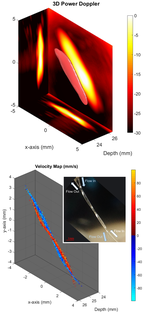In a 2019 article called “3-D Super-Resolution Ultrasound Imaging with a 2-D Sparse Array”, velocities of detected microbubbles were traced using the nearest neighbour method between consecutive frames. An additional measure was used to filter incorrect pairings. If, in consecutive frames, there was more than 50% deviation in volume size between the microbubble echoes, that velocity track was replaced with the next closest microbubble pair after the same size comparison. To accelerate the tracking, a search window was set to allow a maximum microbubble velocity of 100 mm/s, which is larger than the velocity profile expected in human microcirculation.
Velocity maps can easily distinguish opposing flow directions and separate adjacent vessels according to their speed distribution. Therefore, velocity tracking enables further differentiation between vessels otherwise not spatially separated in the image. For this reason, evaluating different tracking methods (including Kalman filters, machine-learning, Hungarian algorithm, Trackmate for ImageJ, etc.) and finding the most suitable technique for super-resolution ultrasound imaging is crucial.
